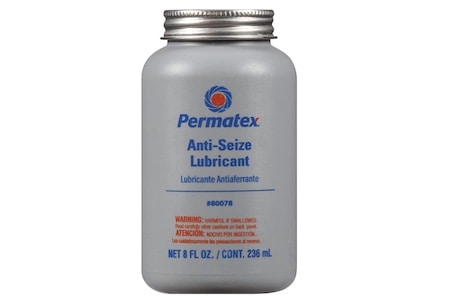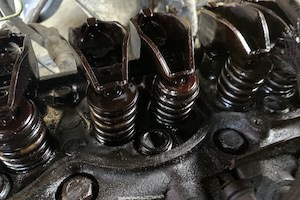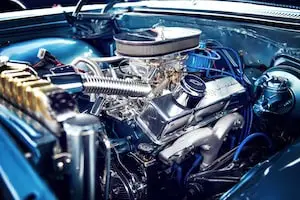Exhaust manifolds heat up and cool down every time you run your engine and the extreme temperatures create an environment that can accelerate corrosion. Seems like a good reason to use a product called Anti-Seize, but there are some instances where anti seize is not recommended. Should you apply anti-Seize to exhaust manifold bolts?
You should apply a thin layer of Anti-seize to exhaust manifold bolts and most other bolts used on the exhaust system. Anti-seize should be applied to other components such as mounts for the catalytic converter, exhaust hangar bolts, and turbo charger mounts.
Because it is is not always intuitive when to use Anti-Seize, we will explain why it should be used on exhaust manifold bolts, the recommended way to apply it as well as a guide to other instances where Anti-seize should be utilized.
Anti Seize Should Be Used on Exhaust Bolts
There is no major down side to applying Anti-Seize to your exhaust manifold bolts or other bolts along the exhaust system. If you use too much, then it will get burned off by the exhaust so apply a reasonable amount and bolt it together with peace of mind and no rusty nuts in the future!
Often exhaust bolts are completely rusted tight and have to be cut off. You will avoid this in the future simply by applying Anti-Seize. Link to Amazon to order Permatex Anti-seize.

What does Anti-Seize do?
Anti-seize is a thread lubricant that provides a layer of protection to both surfaces joined by threads.
It provides a barrier of protection preventing water from entering, prevents the oxidation reaction from occurring between the bolt and the surrounding metal, and it helps to prevent galling of threads.
The expansion and contraction of the metal from heating and cooling contributes to additional strain on the metal and that in combination with oxidation can result in a seized bolt.
Should I apply Loctite to exhaust manifold bolts?
Loctite is not recommended for exhaust manifold bolts because it may lose its effectiveness when heated, and will make it too difficult to remove the bolts in the future. You should apply Anti-seize to manifold bolts in order to prevent them from seizing, and from corrosion.
A better solution is to use a lock washer and apply anti-seize to the threads. It is recommended that you are also careful to tighten bolts to the specifications provided by the manufacturer of your car. These specs can be found in the manual for your vehicle usually at the back of each section in the book.
Where else to Use Anti-seize on my Car
After having a few run-ins with seized engine bolts and exhaust mount bolts that were rusted together so tightly I had to cut them off, I did some digging and now know the most important places to use anti seize.
You should use anti-seize on all the bolts on your exhaust system, intake manifold, and any steel bolts that join aluminum or another metal different from the bolt.
It is recommended to apply anti seize to any bolts prone to seizing. So what bolts are prone to seizing?
The following is a table that is a compilation of where you should and shouldn’t apply Anti-Seize on your vehicle.
| Use Anti-Seize | Do Not Use Anti-Seize | Check with Manufacturer |
| Exhaust Manifold Bolts | Wheel Studs | Engine Mounts |
| Exhaust Hangar Bolts | Spark Plugs | Body Bolts |
| Exhaust Line Bolts | Head Bolts | Mounting Bolts |
| Catalytic Converter Bolts | Brake Caliper Slides | Bolts that frequently get hot |
| Intake Manifold Bolts | Carburetor/F.I. Bolts | Others not included here |
How much Anti-seize to use?
A thin bead of anti-seize about an eighth of an inch thick down the length of the threads of a bolt is sufficient to coat the contact points of the bolt in the threaded area.
This should be spread to an even, thin coat over the entire threads before installing the bolt. Too much anti-seize is when it squishes out the threads and should be avoided especially when the hole that the anti-seize used in leads into the engine block. You do not want to have excess anti-seize drop into your engine. To be sure to not use too much in this case, use a conservative amount of anti-seize. Just enough to coat the threads with a thin layer. This is especially the case for bolts that may have through holes into the engine block such as intake or exhaust manifold bolts.
Here are additional tips for applying anti seize:
- Keep a supply of anti-seize on hand. You will thank yourself every time you do a repair job and have applied a dab of anti-seize when it was assembled. This makes a drastic difference to the disassembly process.
- Clean the threads of the bolts before applying anti seize. A careful wipe down with a rag is sufficient but if needed, use a degreaser and wire brush to be sure that you do not have dirt and grime to fowl the threads of your manifold bolts. Also be sure to clean the threads that the bolt is entering. Especially after machining, run the bolt in and out once before final install, or even better, chase the threads with a tap before installing the bolt.
- Many bottles of anti-seize contain a small brush to apply it. If one is not included use a small brush of your own or apply it with your finger after placing a latex glove on your hand.
- It is always a good idea to replace exhaust bolts and nuts when they are removed. There is plenty of opportunity for corrosion on the underside of your car, and while you are there replacing the catalytic convertor or a leaky exhaust gasket, it is always a good idea to replace the rusted old hardware.


